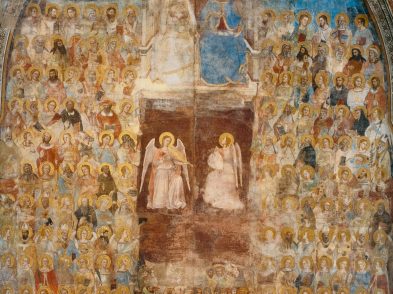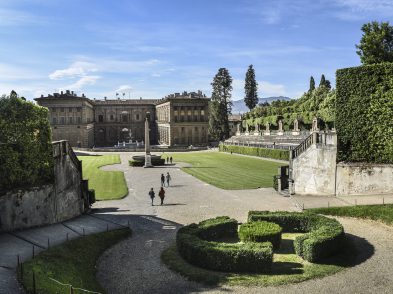There was a raging Twitter debate recently about the magnetizing force of the Impressionists: can there be too much of a good thing? Does the world really need another Impressionists exhibition? Though an affirmative case for both could certainly be made, it seems that the collective interest in the most popular of the modern painters is still going strong.
In our detail-saturated world, perhaps it is comforting that even a century and a half ago, there was a group of artists taking a good, hard look at the world around them—and that the closer they looked, the stranger it all became. Or perhaps it is the opposite: we are a bit astonished that the light so readily emanating from these works is still capable of filling our spirits with a (much-needed) infusion of peace.
Whether it is strangeness or peace that visitors seek, they will find both in the Impressionists at Palazzo Pitti exhibit currently at the Galleria d’Arte Moderna. Gathered in the ballroom of the Pitti Winter Apartments are 12 Impressionist masterpieces on loan from that lovely shrine to the Impressionist gods—the Musée d’Orsay in Paris—in addition to two ‘hometown’ works by Camille Pissarro and another by Alphonse Maureau permanently housed in Florence’s modern art collection.

Claude Monet,The Seine at Port-Villez
The French works came to Florence through a cultural exchange between the two museums. The exhibit I Macchiaioli: Des impressionistes italiens? at the Musée de l’Orangerie in Paris over the summer was enriched with several pieces from the Galleria d’Arte Moderna and explored the intriguing nexuses between the two movements.
As intimated by the exhibit’s straightforward title, the show at Pitti is not one that intends to provide a critical review, nor does it mean to explore the relationship between the French pieces and their Italian ‘counterparts’ in the permanent collection. It seems, quite simply, that they are here to be enjoyed by the Florentine public—a sort of thank-you note to the city for the Orangerie show.
The plot line is simple: exteriors and interiors. No subtexts, no contrived connections and—most importantly given the box-office potential of the subject matter—no gimmicks.

Henri Fantin-Latour, La liseuse
The exhibition opens with ‘En plein air’: here are the landscapes, the light, the blurred gardens and the water. Claude Monet’s La Seine à Port-Villez (c. 1890) is featured, one in the series of 18 canvases the artist painted of the area. A letter explains that Monet painted it one windy summer’s day after two months of bad weather—the fat, fast-moving clouds, the wind-blown trees and choppy water conjure an image of the artist painting in a boat being tossed in the waves.
Also in this section is Auguste Renoir’s startling Étude: Torse de femme au soleil (1875–76). Contemporary criticism was divided on this study of a nude: some found it extraordinary in the use of color, while others were vehement in their critiques. Albert Wolff’s famously harsh words in Le Figaro remain indelibly linked to the painting’s history: ‘Someone needs to kindly explain to Mr. Renoir that a woman’s bust is not a mass of decomposing flesh full of green and violet spots, which indicate the state of complete putrefaction of a cadaver.’
The second section, ‘Interiors,’ features Degas’s sublime ballerinas and Cézanne’s still lifes, created by reducing forms to their most essential terms. La liseuse by Henri Fantin-Latour (1861) features a classic bourgeoisie domestic scene—a young girl reading on a settee—completed following a trip to England with his friend and fellow artist James Whistler.

Auguste Renoir, Étude: Torse de femme au soleil
This section also includes quotes from leading French novelists of the time—Émile Zola, Honoré de Balzac and Guy de Maupassant—which capture something of the Impressionists’ spirit. It is hard to resist Balzac’s ‘Oh my dear. Physically speaking, a stranger is the most adorably feminine person I have ever met. She belongs to that group of women that the Romans used to call flava, fulva, the woman of fire. At first what impressed me the most, and I still love so much, were [those] two yellow eyes, like tigers, golden yellow that shines, gold that is alive, gold that thinks, gold that loves.’
Yet perhaps it is this quote from Zola’s The Kill that will most inspire a visit to this strange and peaceful show: ‘It was autumn: the city under the vast, pale sky faded to a sweet, tender gray, blotched here and there in dark greens that resembled the large leaves of water-lilies floating on a lake…’
Impressionists at Palazzo Pitti
Until January 5, 2014
Galleria d’Arte Moderna, Florence
Autumn on the Rive Gauche
Spend a day in Paris without leaving Florence. Combine the Impressionists at Palazzo Pitti with a visit to the Villa Bardini exhibition Il Rinascimento da Firenze a Parigi: Andata e Ritorno, with works by Botticelli, Donatello, Mantegna and Paolo Uccello on loan from Paris’ Jacquemart–André Museum.
See www.bardinipeyron.it for more information.








